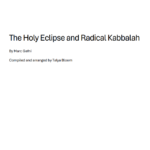Eros and Holiness: Part Two – Marc Gafni
marc gafni
published on marcgafni.com
please share comments on info@marcgafni.com
Eros and Holiness: Part Two
About a week ago, I posted the first in a series of about a hundred posts on Eros and Holiness. The feedback was large and wonderful and very much appreciated. Part of the feedback was “bite-sized” Gafni; these are blog posts―not long essays.
Okay―thanks for the feedback.
So, while I will not repost the framing introduction to this material, which you can find on Blog Post Six, I will start again with the actual material and post in smaller segments with more explanation.
Does that work?
When I first wrote these words―the very first draft―I knew a lot about the joy of Eros, and not enough about the pain of Eros. I knew of feminine beauty, but not enough about feminine shadow. I unconsciously made the equation that many people in the progressive and New Age world make: the feminine = the spiritual. This is, of course, a false equation.
Both feminine and masculine are filled with both light and shadow. While we fully recognize masculine shadow, we are in dangerous denial of feminine shadow. This has many implications in our contemporary understanding of sexuality, power, spirituality, and the relationship between the feminine and masculine in numerous spheres of both personal and public life.
I have thought a lot about the different natures and tripwires of masculine and feminine shadow in the last two years, and will share with you a new understanding of all this over the coming months.
I remain a fierce lover of the Shekinah even as I understand her and accept her in ways I never did.
I owe great thanks to a group of powerful women; the kind of people that Naomi Wolf once referred to as Power Feminists―leading female spiritual teachers, feminist activists, writers, theorists, and simply great women who have held a container for me in these last two years. With some of them, I am now writing in partnership, and I pray that the fruit of our collaboration might make some small contribution to the evolution of love in our time.
I have incorporated the understandings of the last two years into many of the upcoming blog posts.
Much love to every one of you who is reading.
I love every one of you more than you can know!
The posts below begin to speak to ‘What is Eros?’ When I use the word Eros, I do not refer to the sexual. Rather to something much deeper, wider, and more powerful. On the relationship between the sexual and the erotic, please see later posts.
Introduction
The Shechina is the sensual feminine God force that suffuses reality and knows our name. To be a Kabbalist is to participate in the pain of the Shechina. To feel Her hurt. For Her hurt is our hurt. But that is only the first step. The great ambition of the spirit is to heal Her pain, to fill Her up with joy, ecstasy and meaning. To repair our broken world. To heal Her wound. For She is us.
Shechina in the original Hebrew means “indwelling Presence.” She evokes the experience of fullness, presence, interconnectivity, and yearning. The Greeks called this experience ‘the erotic’ after the god Eros. Eros and Shechina are different expressions of the same core experience. One cannot define Shechina and Eros. To define Shechina is to kill her. Definitions are non-erotic. Shechina is evoked, intuited, felt, and experienced. And yet the mind needs maps and signposts. So, later in our journey (in chapter two), we will unfold together the four faces of Eros. But to begin, we seek rather to arouse her presence.
The opposite of Eros and Shechina is void. Our lives are overflowing with the Void. You know the void. The big hole you feel inside. Sometimes it hurts so much you can barely move. Usually, it is a dull and throbbing pain. The background noise of most lives. We rush around, doing everything we can to fill the absence. We even have a handy word for this rushing about: avoidance, to avoid the emptiness. A—void—dance. A dance around the void. We develop the most elaborate maneuverings you can imagine―never realizing that it is all a-void—dance.
That if we could but taste fullness for a moment, the empty dances of addiction, power, violence, and abusive sex(3) would be transformed into the erotic dance of Being. The dance with the Goddess Divine, with the Shechina. The dance in which we all have a place. This sacred conversation is about sharing that dance with you.
Marc Gafni
Please feel free to send comments to info@marcgafni.com.








